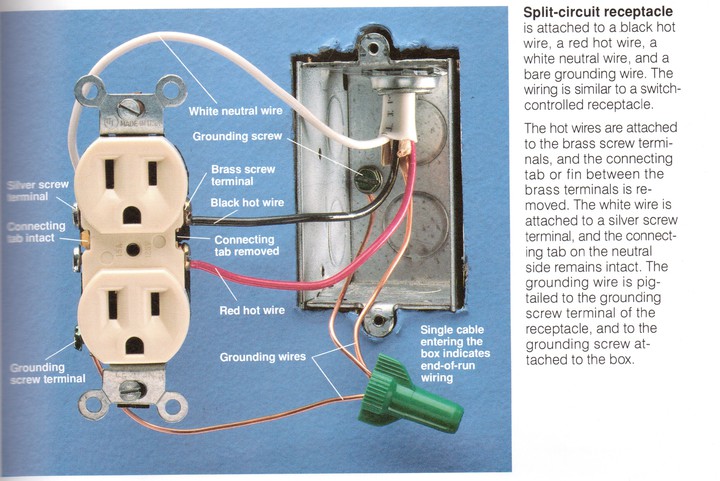While on the topic or receptacle wiring, may as well toss out another question/preference so we can all crawl back out of the woodwork (ME included lol). Like I said, I love and enjoy every post on this stuff and the more the merrier I figure, its NOT a race ya know. If I ask a question and get 10 same opinions I feel MUCH better then if 5 say one thing and 5 say the other lol
Okay, say you're running out a receptacle branch circuit in which case you wire INTO a receptacle and then go OUT OF it to another receptacle downstream. Many times you see where an "electrician" or "Billy Bob" perhaps??? in effect used the 2 screws on the side of the receptacle TO SPLICE THE IN AND OUT BRANH CIRCUIT WIRES.
As yall know its not good to have an Open Neutral and its the UnGrounDED Conductor that gets switched, NOT the GrounDED Conductor ie you switch the HOT NOT THE NEUTRAL (don't break a Neutral)
Theres an alternative, of course, if you don't use the receptacle as a splice. That is to run 3 wires (in,, and out,,, and pigtail) into a wire nut to splice the branch circuit wiring and then run the one wire pigtail to the receptacles screw terminal. If an electrician is replacing a receptacle he doesn't have to break the Neutral circuit open, he just removes the pigtail and attaches it to the new receptacle, even though the circuit is shut off at the panel breaker.
SOOOOOOOOO Billy Bobs and Electricians alike, WHATS YOUR PREFERENCE. PS, I preferred deep boxes where possible to allow room for wires and splices and wire nuts etc etc. It takes up a lot of room just to ground a metal box plus splice the grounds plus wire to the receptacles ground lug PLUS splice the hot and neutral LOTS OF WIRES N NUTS IN THERE LOL I liked those greenies grounding wire nuts with wire hole out the top and the little braided grounding pigtails for box ground.
An NEC rusty as an old nail sparky, John T
Okay, say you're running out a receptacle branch circuit in which case you wire INTO a receptacle and then go OUT OF it to another receptacle downstream. Many times you see where an "electrician" or "Billy Bob" perhaps??? in effect used the 2 screws on the side of the receptacle TO SPLICE THE IN AND OUT BRANH CIRCUIT WIRES.
As yall know its not good to have an Open Neutral and its the UnGrounDED Conductor that gets switched, NOT the GrounDED Conductor ie you switch the HOT NOT THE NEUTRAL (don't break a Neutral)
Theres an alternative, of course, if you don't use the receptacle as a splice. That is to run 3 wires (in,, and out,,, and pigtail) into a wire nut to splice the branch circuit wiring and then run the one wire pigtail to the receptacles screw terminal. If an electrician is replacing a receptacle he doesn't have to break the Neutral circuit open, he just removes the pigtail and attaches it to the new receptacle, even though the circuit is shut off at the panel breaker.
SOOOOOOOOO Billy Bobs and Electricians alike, WHATS YOUR PREFERENCE. PS, I preferred deep boxes where possible to allow room for wires and splices and wire nuts etc etc. It takes up a lot of room just to ground a metal box plus splice the grounds plus wire to the receptacles ground lug PLUS splice the hot and neutral LOTS OF WIRES N NUTS IN THERE LOL I liked those greenies grounding wire nuts with wire hole out the top and the little braided grounding pigtails for box ground.
An NEC rusty as an old nail sparky, John T


